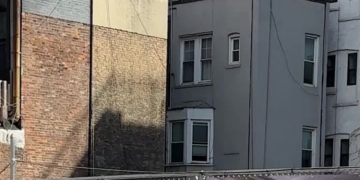On a quiet block in Manhattan’s Little Ukraine in the East Village, passers-by are confronted with haunting reminders of war. A 100-foot-long mural shows children’s beds lined with stuffed animals and toys, but no children, symbolizing the thousands of Ukrainian children who were separated or taken from their families since Russia invaded their country in 2022.
The piece, titled “Empty Beds, is an eight-foot-tall photographic installation by the artist Phil Buehler. It was officially introduced on Saturday, when children tugged their parents closer to look at the cuddly toys, while other visitors sat on yellow folding chairs nearby to reflect.
The mural, on display until Nov. 30 at 44 Second Avenue (at East Second Street), uses the visual language of absence to signify the continuing war in Ukraine.
Buehler photographed the beds at eye level to draw viewers into the intimate spaces filled. “I wanted to place viewers in the perspective of the children themselves,” he said.
One striking image shows Rostislav Lavrov’s bed, with a Yankees baseball cap hanging from its edge. Taken by Russian soldiers from his home in Kherson when he was 16, he was transported through multiple camps in occupied Crimea, where he faced constant pressure to renounce his Ukrainian citizenship. After months of forced relocation and isolation, he made a daring escape across a neutral border zone into Ukrainian-controlled territory. He later testified to the U.S. Congress.
Rostislav’s bed is in temporary housing; originally, Buehler planned to photograph the bedrooms of children who are still missing, but war crime investigations in Ukraine prevented his access.
Instead, the photos in the installation, taken outside Kyiv, in Tarasivka and Hatne, show the personal belongings of children who have returned, such as stuffed animals, toys and, in Rostislav’s case, a baseball cap and his clothes.
Iryna Rozdolska, a visitor to the mural, said: “I usually try to block out difficult stories from Ukraine, just to keep myself steady for my kids. But this time, I allowed myself to feel, and I felt both pain and hope as I watched people pause to understand these stories.” She added that her 7-year-old son was particularly affected, saying repeatedly, “I feel so sad for those kids.”
Other photographs show children’s drawings found in bombed-out apartments — a bright rainbow, a Ukrainian flag, an owl on a tree. The pictures serve as a somber reminder: Nearly 20,000 children have been abducted, with many still unaccounted for, according to the Children of War portal, a project supported by the Ukrainian government. Just 388 children have been safely returned after being taken to Russia or Russian-controlled territories.
The installation also features interactive elements. Visitors can hold and touch stuffed animals, and listen to Ukrainian lullabies.
“The lullabies are sweet and soothing,” Buehler said. “But when you realize they’re meant for children who were abducted or displaced by war, the meaning shifts, becoming much more poignant.”
Buehler, 68, has been making art for the last five decades, including large-scale installations, documentary-style photography and films addressing political issues. His past work includes “Wall of Lies,” from 2020, a 50-foot-long banner displaying misleading statements made by Donald Trump and other people regarding the legitimacy of the 2020 U.S. presidential election. Buehler refers to this type of work as cycloramas, intended to create a 360-degree viewing experience.
The idea for “Empty Beds” came from a deeply personal moment a decade ago, when Buehler saw a bedroom preserved for a friend’s daughter who was killed by a drunken driver.
For this mural, Buehler traveled to Ukraine twice, in October 2023 and September 2024. After his first trip, he created a 60-foot-long photograph of a “car cemetery,” showing abandoned and destroyed vehicles in Irpin, one of the Kyiv suburbs ravaged early in the invasion.
“I think every parent can imagine there’s some loved child there,” Buehler said, referring to the bedroom photos. He hopes the mural, spanning an entire block, creates space for viewers to reflect on loss and waiting.
“I wanted it out on the street, where anyone passing by could stop and engage with the work,” he said.
To bring the installation to life, Buehler collaborated with Bird of Light Ukraine, a New York-based N.G.O. focused on humanitarian efforts. Bird of Light connected him with key organizations in Ukraine, among them the Ukrainian Child Rights Network and President Volodymyr Zelensky’s Bring Kids Back initiative.
The illegal removal of Ukrainian children has been one of the war’s most painful consequences, with many families torn apart and children deprived of their cultural identity. “The children held by Russia are forbidden to speak Ukrainian, and their identities are being systematically erased,” said Zhanna Galeyeva, a founder of Bird of Light Ukraine.
Buehler hopes “Empty Beds” will inspire viewers to act — whether by donating or spreading awareness.
“Art must engage people,” he said. “Sometimes the photographs make them curious. Then they get closer and realize the deeper story.”
The post In ‘Empty Beds,’ a Stark Reminder of War’s Youngest Victims appeared first on New York Times.



















